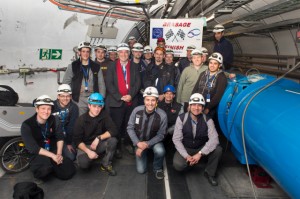The LHC has been shut down for consolidation since the beginning of 2013. This break is called Long Shutdown 1 or LS1. One of the biggest jobs has been the opening and inspection of all the 1695 magnet-magnet interconnects. They had to be carefully checked and sometimes repaired to make sure that they can take the current needed for running the LHC at up to 14 TeV after LS1. One interconnect had failed spectacularly right after the start-up of the LHC in 2008 and it was decided that the LHC would only run at 7 TeV in its first years. The inspection of all interconnects was completed at the end of March (photo courtesy Michael Struik/CERN) and more than a quarter of the accelerator has already been permanently closed and leak-tested again. Now begins the long job of re-commissioning, starting with the testing of all high-current circuits with short-circuit loads instead of the superconducting magnets.
At the beginning of May, the cooldown of the first of eight sectors will start. Since nitrogen is not allowed in the tunnel, the first phase of cooldown from room temperature to 80K (-193 degrees Centigrade) is made by circulating helium gas, which is cooled by liquid nitrogen in a heat exchanger on the surface, through the magnets. Each sector requires 1200 tons of liquid nitrogen, that means 60 trucks each carrying 20 tons, and the cooldown will take about 3 weeks. To get from 80K to 4.5K, the main refrigerators are used to circulate liquid helium. Finally, to get from 4.5K to 1.9K, the final operating temperature, the “cold compressors” are switched on, reducing the pressure above the helium to 15 mbar.
Once the first sector is closed, power tests can begin in earnest. It was found during initial commissioning in 2008 that some of the main dipoles have “memory loss”, meaning that even though they were trained on the test benches to above their operating level, at high current some re-training still occurs and needs to be done in the tunnel. All this is to avoid quenches, loss of superconductivity that can be due to small mechanical movements in the coils under the very high magnetic forces. Experience shows that the magnets can be brought very quickly up to a field corresponding to 6.5 TeV, but that the last half-a-TeV (to get to the nominal 7 TeV) requires quite a lot more time. It has therefore been decided to start high-energy running at 6.5 (centre-of mass energy 13) TeV, using the end of physics runs for machine studies to push the field higher thereby training to full current in masked time.
The cooldown of the whole machine should be complete by the end of September. It is foreseen to start commissioning with beam at the beginning of February 2015. Physics data taking can start at the end of March. Then we will see what this new energy range has in store for us and how it will guide the planning of the ILC.



Thanks for this very important milestone achievement for the new stage in the LHC and is also a step to prepare for the ILC.